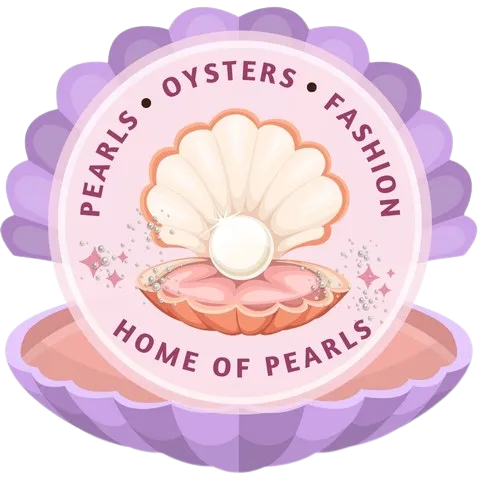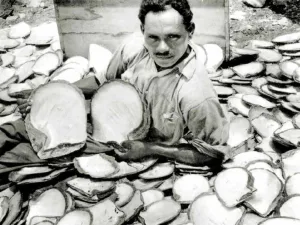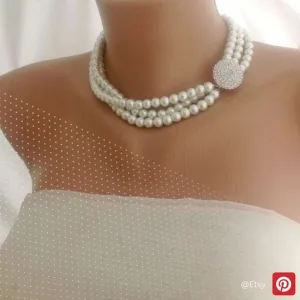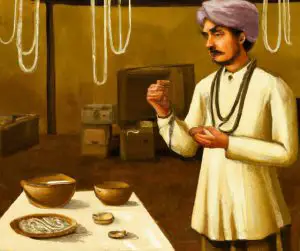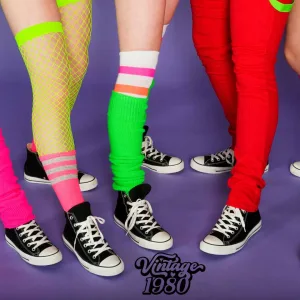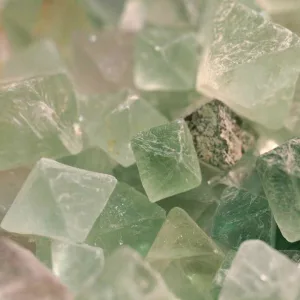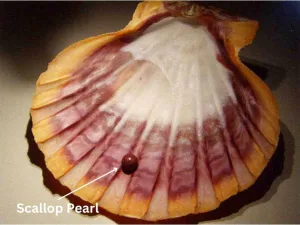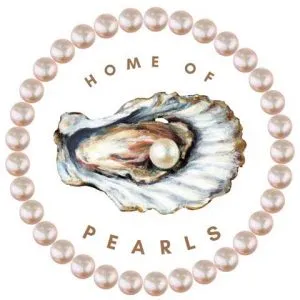Pearls are one of the most prized gems in the world, thanks to their unique luster and understated, elegant appearance. For millennia, they have been coveted by the wealthy and powerful all around the world.
Pearls are unique in the world of gems because they are not stones, like most other gems. Instead, they form from oysters and are one of the few gems that come from an animal, not the ground. In their small, lustrous rounds, pearls hide an enormous wealth of history and insight into a unique natural process.
Learning more about where pearls come from can help us appreciate their value and beauty.
Table of Contents
- How Are Pearls Formed?
- The History of Pearls
- The History of Cultivated Pearls
- How Are Cultivated Pearls Made?
- The Future of Pearls
How Are Pearls Formed?
Pearls are formed by oysters, which are bivalve mollusks, or shelled creatures whose shell is in the shape of two halves held together by a hinge-like structure in the middle.
A pearl starts when an irritant enters the oyster’s shell and lodges in the soft flesh in the middle. Stereotypically, people think that pearls form around grains of sand, but this is actually quite rare. Usually, the irritant is a parasite or some other form of organic material.
When the irritant enters the oyster, it hurts the sensitive flesh. To protect itself, the oyster secretes nacre, a milky protective substance made out of aragonite and conchiolin. Layers and layers of nacre, also called mother-of-pearl, form around the irritant, eventually forming a pearl.
Pearls that are found in the wild are saltwater pearls because oysters naturally live in salty or brackish waters. Now, freshwater pearls are becoming more popular as a way to meet the demand of consumers for beautiful pearls (more on the distinction later).
The History of Pearls
The mystique around pearls is as much a product of their history as it is of the natural processes that lead to their formation.
For hundreds, even thousands, of years, pearls have been widely prized. Scientists have found evidence that pearls were valued and traded as long ago as the Neolithic period.
Since ancient times, people highly valued pearls, especially jewelry made out of pearls. Before the development of techniques to cultivate pearls, finding them was highly rare, and finding enough pearls that were nearly identical to make jewelry was even rarer. For a while, pearls were known as “The Queen of Gems.”
Many different societies placed a high value on pearls. For example, in ancient Egypt, pearls were an important substance as long ago as the fifth century B.C. In almost every Chinese dynasty, pearls were the most important gift that someone could give to a royal.
Ancient Romans were so obsessed with pearls, a fashion trend that reached its peak in the first century A.D., that women would sew pearls into their clothing in addition to wearing them as jewelry. Cleopatra famously dissolved a pearl into wine to woo Marc Antony (although this story may be apocryphal).
Dynasties and empires rose and fell, but the craze for pearls never went away. The 15th and 16th centuries are sometimes called the Pearl Age because European elites were gripped with a craze for pearls, especially thanks to the discovery of new sources in the Americas.
However, the never-sated appetites of the wealthy, along with growing industrialization, destroyed popular pearl sources, which meant that by the 19th century, many natural sources of pearls from the rivers of America to the South Pacific were depleted.
The History of Cultivated Pearls
While the demand for pearls never waned—in fact, it only grew—the global supply was dwindling fast. It looked as if people would never be able to get the pearls they wanted. However, in 1892, a Japanese merchant named Mikimoto Kokichi popularized cultivated pearls.
At the time in Japan, the problem of how to artificially cultivate pearls was stumping many intellectuals.
Two other people, Tokichi Nishikawa and Tatsuhei Mise, had invented a technique to start pearl culturing by using a grafting needle to insert a piece of the membrane surrounding a shell into the oyster.
Kokichi took this method further by perfecting the cultivation method to produce round, hemispherical pearls.
He was also a shrewd businessman who eventually bought the patent to the Mise-Nishikawa method and perfected it by discovering the best material for culturing: a piece of U.S. mussel shell.
For years, Kokichi held a monopoly on cultivated pearls, and even when his secrets got out, his influence on the industry cannot be denied.
How Are Cultivated Pearls Made?
Today, pearl cultivators use many of the same methods that Kokichi (and his less famous fellow inventors) used over a hundred years ago.
Cultivators induce pearl growth by introducing an irritant into the pearl. The oysters are left in the oyster farm to grow the pearl before harvesting.
Most pearls on the market today are cultivated pearls because natural pearl reserves were nearly depleted due to overharvesting.
They can come from many different places, including Tahiti, the South Sea, and Ago Bay in Japan, the home of Akoya pearls. These pearls are all saltwater pearls.
There are also freshwater pearls, which come from fresh waters such as rivers. Since oysters naturally prefer brackish waters, freshwater pearls often come from other mollusks, such as mussels and clams.
China is the world’s leading producer of freshwater pearls and has pushed the boundaries of what pearl manufacturing can look like, developing massive farms and techniques to vary the color and even number of pearls a mollusk can produce at once.
The Future of Pearls
The future of pearls clearly lies in cultivated pearls, although some wild pearls are still available, and different countries are taking steps to restore wild oyster populations.
However, even cultivated pearls are threatened by climate change and its impact on marine habitats. More frequent tropical storms destroy oyster populations, setting production back in farms for years.
Changing water temperatures and salinity also affect the quality and growth rate of pearls, although more research is still needed on the impact of climate change. One thing is certain, though: pearls will continue to be valued for their beauty.
